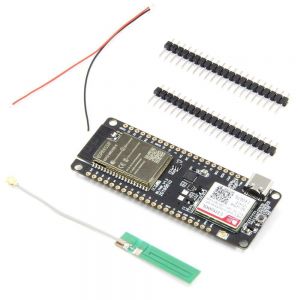ILYGO® TTGO T-Call V1.3 ESP32 Wireless Module GPRS Antenna SIM Card SIM800L Board: Difference between revisions
Jump to navigation
Jump to search
(Created page with "{| class="wikitable" style="float:right; margin-left: 10px;" | {{FULLPAGENAME}} | {{#qrlite:{{fullurl:{{FULLPAGENAME}}}}|format=svg|size=2|ecc=1|margin=0}} |- | colspan="2"|...") |
mNo edit summary |
||
| (4 intermediate revisions by the same user not shown) | |||
| Line 8: | Line 8: | ||
== Features == | == Features == | ||
[[File:Module ILYGO® TTGO T-Call V1.3 ESP32 Wireless Module GPRS Antenna SIM Card SIM800L Board.jpg|thumb|Module ILYGO® TTGO T-Call V1.3 ESP32 Wireless Module GPRS Antenna SIM Card SIM800L Board]] | |||
More Information: https://github.com/Xinyuan-LilyGO/TTGO-T-Call | |||
Package includes: | |||
# 1 x T-Call V1.3 | |||
# 1 x Power cord | |||
# 2 x Pin header | |||
# 1 x GPRS antenna (9cm) | |||
=== Schematic === | |||
[[File:Schematic ILYGO® TTGO T-Call V1.3 ESP32 Wireless Module GPRS Antenna SIM Card SIM800L Board.jpg|1000px]] | |||
Hardware Specifications | |||
* Chipset ESPRESSIF-ESP32 240MHz Xtensa® dual-core 32-bit LX6 microprocessor | |||
* | * FLASH QSPI flash 4MB / PSRAM 8MB | ||
* | * SRAM 520 kB SRAM | ||
* | * Button Reset | ||
* | * USB to TTL CP2104 | ||
* | * Modular interface UART, SPI, SDIO, I2C, LED PWM, TV PWM, I2S, IRGPIO, capacitor touch sensor, ADC, DACLNA pre-amplifier | ||
* | * On-board clock 40MHz crystal oscillator | ||
* | * Working voltage 2.7V-3.6V | ||
* | * Working current About 70mA | ||
* Sleep current About 300uA | |||
* SIM card Only supports Nano SIM card | |||
* Working temperature range -40℃ ~ +85℃ | |||
* Size&Weight 78.83mm*28.92mm*8.06mm(11.77g) | |||
* Power Supply Specifications | |||
* Power Supply USB 5V/1A | |||
* Charging current 500mA | |||
* Battery 3.7V lithium battery | |||
* JST Connector 2Pin 1.25mm | |||
* USB Type-C | |||
* Wi-Fi | |||
* Standard FCC/CE-RED/IC/TELEC/KCC/SRRC/NCC | |||
* Protocol 802.11 b/g/n(802.11n, speed up to150Mbps)A-MPDU and A-MSDU polymerization, support 0.4μS Protection interval | |||
* Frequency range 2.4GHz~2.5GHz(2400M~2483.5M) | |||
* Transmit Power 22dBm | |||
* Communication distance 300mbluetooth | |||
* Protocol meet bluetooth v4.2BR/EDR and BLE standard | |||
* Radio frequency with -97dBm sensitivity NZIF receiver Class-1,Class-2&Class-3 emitter AFH | |||
* Audio frequency CVSD&SBC audio frequency | |||
Software specification | |||
* Wi-Fi Mode Station/SoftAP/SoftAP+Station/P2P | |||
* Security mechanism WPA/WPA2/WPA2-Enterprise/WPS | |||
* Encryption Type AES/RSA/ECC/SHA | |||
* Firmware upgrade UART download/OTA(Through network/host to download and write firmware) | |||
* Software Development Support cloud server development /SDK for user firmware development | |||
* Networking protocol IPv4, IPv6, SSL, TCP/UDP/HTTP/FTP/MQTT | |||
* User Configuration AT + Instruction set, cloud server, android/iOSapp | |||
* OS FreeRTOS | |||
Software for the gateway: [https://github.com/tinel-c/PlatformIO_Arduino_SIM800_ESP32] | |||
[https:// | |||
[[Category:Data conversion modules]] | [[Category:Data conversion modules]] | ||
Latest revision as of 11:49, 7 May 2023
| ILYGO® TTGO T-Call V1.3 ESP32 Wireless Module GPRS Antenna SIM Card SIM800L Board |
|
| https://bogza.ro/index.php/ILYGO%C2%AE_TTGO_T-Call_V1.3_ESP32_Wireless_Module_GPRS_Antenna_SIM_Card_SIM800L_Board | |
Features

More Information: https://github.com/Xinyuan-LilyGO/TTGO-T-Call
Package includes:
- 1 x T-Call V1.3
- 1 x Power cord
- 2 x Pin header
- 1 x GPRS antenna (9cm)
Schematic
Hardware Specifications
- Chipset ESPRESSIF-ESP32 240MHz Xtensa® dual-core 32-bit LX6 microprocessor
- FLASH QSPI flash 4MB / PSRAM 8MB
- SRAM 520 kB SRAM
- Button Reset
- USB to TTL CP2104
- Modular interface UART, SPI, SDIO, I2C, LED PWM, TV PWM, I2S, IRGPIO, capacitor touch sensor, ADC, DACLNA pre-amplifier
- On-board clock 40MHz crystal oscillator
- Working voltage 2.7V-3.6V
- Working current About 70mA
- Sleep current About 300uA
- SIM card Only supports Nano SIM card
- Working temperature range -40℃ ~ +85℃
- Size&Weight 78.83mm*28.92mm*8.06mm(11.77g)
- Power Supply Specifications
- Power Supply USB 5V/1A
- Charging current 500mA
- Battery 3.7V lithium battery
- JST Connector 2Pin 1.25mm
- USB Type-C
- Wi-Fi
- Standard FCC/CE-RED/IC/TELEC/KCC/SRRC/NCC
- Protocol 802.11 b/g/n(802.11n, speed up to150Mbps)A-MPDU and A-MSDU polymerization, support 0.4μS Protection interval
- Frequency range 2.4GHz~2.5GHz(2400M~2483.5M)
- Transmit Power 22dBm
- Communication distance 300mbluetooth
- Protocol meet bluetooth v4.2BR/EDR and BLE standard
- Radio frequency with -97dBm sensitivity NZIF receiver Class-1,Class-2&Class-3 emitter AFH
- Audio frequency CVSD&SBC audio frequency
Software specification
- Wi-Fi Mode Station/SoftAP/SoftAP+Station/P2P
- Security mechanism WPA/WPA2/WPA2-Enterprise/WPS
- Encryption Type AES/RSA/ECC/SHA
- Firmware upgrade UART download/OTA(Through network/host to download and write firmware)
- Software Development Support cloud server development /SDK for user firmware development
- Networking protocol IPv4, IPv6, SSL, TCP/UDP/HTTP/FTP/MQTT
- User Configuration AT + Instruction set, cloud server, android/iOSapp
- OS FreeRTOS
Software for the gateway: [1]
